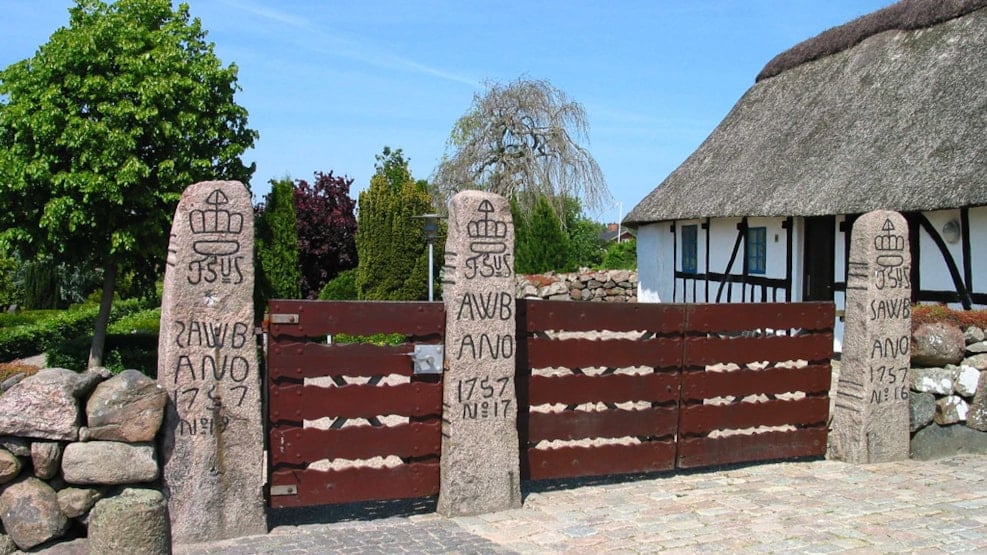
Royal stones by the Hundslund Church
At the entrance to the cemetery by Hundslund Church, three very distinctive stones stand that are not related to Christianity but to the royal Danish hunting grounds of the 18th century. The stones are clearly visible from the main road between Horsens and Odder.
The historical entrance to the cemetery
The three game law poles—also known as game law stones—constitute a prominent feature at the entrance to the cemetery in the village of Hundslund, north of Horsens Fjord. The stones have no connection to religion, and the inscriptions on them served purely practical and informative purposes. At the top of the stones, a crown symbolizes that this was the entrance to a royal hunting area. Below the crown is the monogram of Frederick V. Just beneath that are some initials indicating game law districts along with the year the stone was made, 1757, and finally, at the bottom, the stones' numbers within the game law district are indicated.
These stones were part of the many markers that defined the vast Skanderborg Game Law, which stretched from Horsens to Viborg. When the game law was sold to private individuals in 1767, there were 112 stones, typically placed prominently in the landscape—on a hilltop, burial mound, or similar locations. At that time, the stones were not protected, and many of them have since been moved from their original positions, including the stones at Hundslund, which originally stood at Åkjær, quite close to Hundslund. The stones at Hundslund are among the latest erected and best preserved of their kind.
About the royal stones
Game law stones are boundary markers that were meant to delineate the boundaries of the royal game preserves found throughout Denmark. These game preserves were primarily established during the reign of Frederick II in the 16th century. Through land swaps, purchases, sales, and trades, the hunting-loving king amassed large contiguous areas where he could establish his hunting districts, or game preserves.
Only late did the antiquities authorities begin to regard the game law poles as worthy of preservation, which is why many have been lost over time.
The stones represent a fairly uniform group of historical monuments. They are tall and slender, carved from granite. Another characteristic feature is that the inscription on the front of the poles follows a consistent structure, similar to that of the stones at Hundslund.
The first major royal game preserve created was Koldinghus in 1579. However, it was not until the time of Christian IV around 1688 that the preserves were marked with stones. The stones were positioned approximately one kilometer apart.
Farmers and others who owned land in the area had to accept that their land would be used as a hunting ground. If they had a dog, one of its front legs would be severed—this way, it was known that the dog was not to be shot.
Other historical attractions
The game law stones in Hundslund stand right next to the village church, which is also worth visiting if you're looking to see the game law stones. You can read more about Hundslund Church here.
If you want to see other game law stones in the area, we recommend the stone located along a path between Underup and Nim. This stone is found in a high area with an unusually large number of burial mounds. There are more than 20 burial mounds in the vicinity of Vorbjerg Høje and Slaggård Banke.
Kystlandet offers many exciting historical attractions, ranging from ancient times to industrial history, museums, buildings, and natural attractions. On this page, you can find inspiration for historically interesting experiences near Horsens, Odder, and Juelsminde.